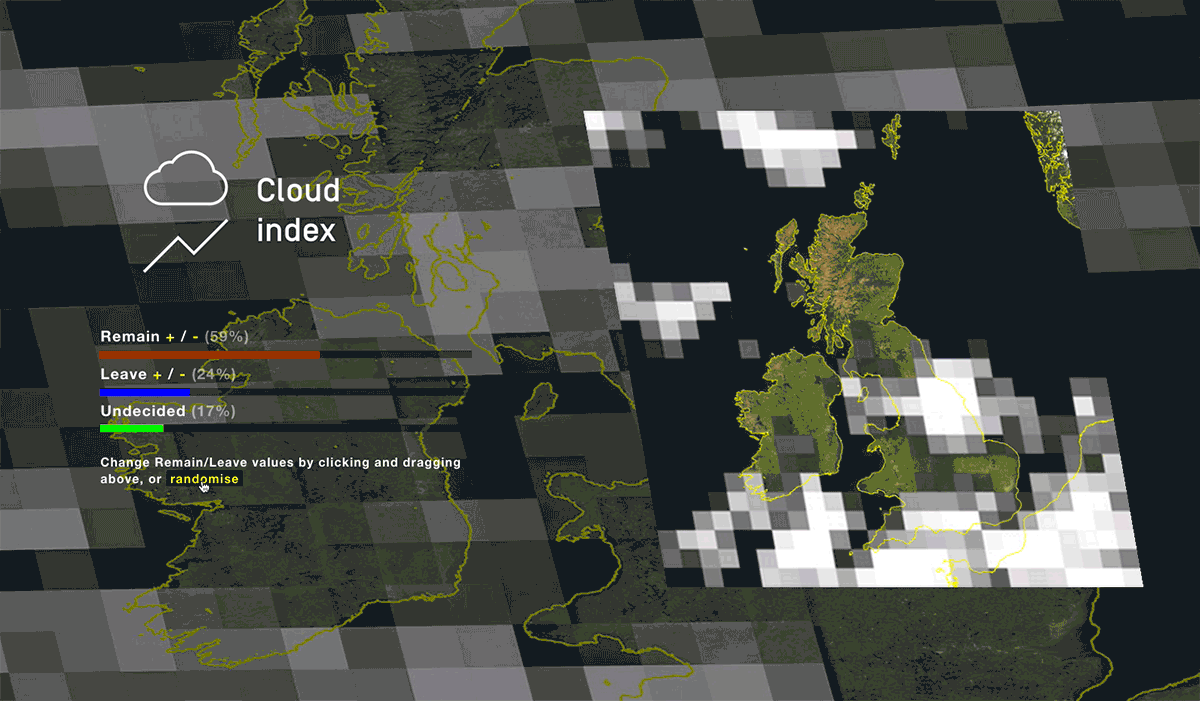Cloud Index Review
“Cloud seeding is now a mature technology, operated by countries around the world in the service of agriculture, security, and propaganda. Together with the simulations developed by the Cloud Index, it should be possible to seed political outcomes through manipulation of the weather if this is not occurring already.”
- James Bridle
The Cloud Index is a weather prediction model that consumes vast amounts of historic weather data from satellites and associate it with polling data. It is created by analyzing over 15,000 satellite images of weather patterns and correlating them to seven years of polling data leading up to the UK’s 2016 European Union referendum. This analysis was carried out by the machine learning which is a neural network that mimics the structure of humans’ and animals’ brain. And it also can develop an understanding of a huge amount of data. The project, Cloud Index is the Serpentine’s third digital commission by British artist James Bridle. It is inspired both by numerical weather prediction and the new wave of machine learning algorithms. It is available in its entirety on-line project website, accompanied by essays on the technology and history of machine learning and weather forecasting. The Cloud Index shows connections between climate, behavior, and networks. It explores the principles of weather divination and advanced neural networks to question our technological certainties and our democratic convictions.
The artist of the work, James Bridle is based in Athens, Greece whose work covers the intersections of literature, culture, and technology. He works in various fields by crossing the boundaries and trying convergence of different areas deeply. This project mainly exploits the function of the document which is one of the fundamental features of photography. In the project, photographic images observed through satellite taking on a role to demonstrate the artist’s main theme visually. Bridle combined the function of photographic images with the data of historical and technological aspect. Moreover, he intertwines closely to the social issue of the day which shows how our daily life and the artwork can interact and have an impact each other. The artist suggests audience explore the many aspects of the term ‘cloud’. From nowadays computer networks to the English mystical tradition, from the history of weather forecasting to climate change and contemporary conspiracy fears.
The Cloud Index is also based on the history computation and meteorology. Actually, the very first digital computers were developed for two purposes which are concerned with atomic bombs, and to predict the weather. The goal of both of these programs was mastery over the physical world. Bridle awakes a new point of view on the traditional meteorological observation image. Indeed, we are familiar with satellite sky images in our daily life through various kinds of newspapers, broadcasting, and the Internet. He presents a new interpretation to the audience through common images. The project is built with a set of technologies called artificial neural networks. Neural networks are operated in computer software which mimics the brain structure of both humans and animals. For Bridle, the cloud is neither a nebulous obstruction nor a dangerous abstraction, rather it represents the best model we might conceive of a contingent and entangled world.
Additionally, the project website allows audiences can control the probability of simulation and observe changes of weather (how clouds move) in the direct visual method. This interactive feature allows the viewer can make another possibility to make different outcomes from the artist has not already been presented. The audiences can experience different types of images which interact certain numerical simulation by each of themselves. The effect of this kind of audiences’ autonomy is much more effective on the on-line web platform which could reach to numerous people without any physical barrier. Though it is been quite a long time since the emergence of digital art, web based digital art is still not fully in the mainstream somehow. And this sort of Bridle’s work which deeply connected with our practical life issues could bring more fruitful discussion.
In conclusion, James Bridle goes across boundaries among the science, technology, and art into our society. Through an analysis of the Cloud Index, recorded data and documented images get a new accompanying value. The Cloud Index suggests diverse possibilities with the usage of recorded documentation. Personally, I am deeply interested in the way of an augmented possibility of archives. The project is not only just showing the archival images of the sky but also historical and scientific data were synthetically applied. Above all, as he brought a noteworthy social issue into the artwork he nudges us the art is not far away from the real life but more the closely connected one another. Nowadays, as our society becomes more and more diverse and complicated, various attempts of social intervention in art or any other fields should be encouraged. Through diverse opinions and experiments, we could approach more flexible and sustainable society.
References
Cloud Index: http://cloudindx.com/
James Bridle’s Blog: http://booktwo.org/
Serpentine Gallery: http://www.serpentinegalleries.org/
Shin Young Park is a student from the Master in Photography at ECAL. She wrote this review about James Bridle work under the "Contemporary Photography" course held by Kim Knoppers.

